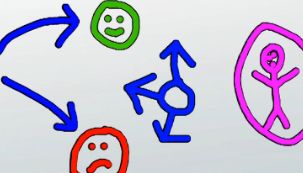The Planned Change Process - Quiz
Choose your answer and write the correct one down. Then click HERE for the answers to this quiz.
NOTE: The transcript from the video is listed below the quiz for your reference.
1. Which of these steps in the planned change process provides the objective or expectation of how a change will respond to whatever
- develop change goals
- evaluate the plan
- develop the change plan
- select the change agent
- implement the change
2. Which of these steps in the planned change process provides a roadmap for how the change will be implemented?
- develop the change plan
- develop change goals
- evaluate the plan
- select the change agent
- implement the change
3. Which of these steps in the planned change process requires managers at all levels to be aware of the internal and external forces that potentially compromise the success and long-term sustainability of the organization?
- recognize the need for change
- develop the change plan
- develop change goals
- evaluate the plan
- implement the change
4. Which of these steps in the planned change process puts the change plan into action?
- implement the change
- recognize the need for change
- develop the change plan
- select the change agent
- evaluate the plan
5. During which of these steps in the planned change process is used to determine how ready the organization and its members are for the change?
- develop the change plan
- develop change goals
- select the change agent
- evaluate the plan
- implement the change
Change is one of the most challenging events an organization will go through. This lesson describes the steps of the planned changed process, which include recognizing the need for change, developing change goals, appointing a change agent, assessing the current climate, developing and implementing a change plan and evaluating the plan's success.
The Planned Change Process
Change is often one of the most challenging events an organization will go through. At times it may seem like trying to climb the Himalayan mountains barefoot! From the moment a change becomes necessary through its implementation, a great deal of factors come into play. To maximize the success of any organizational change, managers need to create and follow a logical sequence of steps to ensure the objectives of the change are accomplished. The planned change process is typically made up of the following steps:
- Recognize the need for change
- Develop change goals
- Appoint a change agent
- Assess the current climate
- Develop a change plan method for implementation
- Implement the plan
- Evaluate the success of the plan at reaching the change goals
 |
Recognize the Need to Change & Determine Goals
In today's business environment there are many factors that force an organization to change. These factors can be internal to the organization (such as employees, culture, policy or procedures) or external (such as customers, competitors, the economy or politics). Managers at all levels (top, middle and low level) must be aware of these internal and external forces that potentially compromise the success of the organization and promptly respond by changing some aspect of the organization. Recognizing the need for change is pivotal to the long-term sustainability of an organization.
 |
Establishing a Sense of Urgency
Once a manager recognizes that a change should happen in the organization, he or she must be certain to understand why the change is needed. Developing change goals provides managers with the objective or expectation of how a change will respond to whatever internal or external forces are driving the need to change. For example, when Redbox made its explosive entrance into the marketplace with its movie kiosk service, Blockbuster was forced to duplicate this offering in order to stay in business. Redbox essentially created a service that literally stole the customer base from many traditional movie stores by offering the same product at a fraction of the price and at a convenient location. This required traditional movie stores like Blockbuster to recognize they needed to change what they offered as well to meet their goal of staying in business.
Appointing a Change Agent
Once a manager recognizes that a change must happen in the organization and develops the change goals, he or she needs to select somebody to carry out that change. The change agent is someone who serves as a leader during change development and implementation. They are typically forward-thinking individuals who are highly charismatic, good with people and capable of inspiring the workforce to accept the change and even aid in the implementation. It is important to note that while change agents are leaders, not all leaders are change agents. In fact, many organizations will hire someone outside of the company to serve as a change agent due to their expertise and unique abilities to drive change.
 |
Assess the Current Climate
One thing that change agents are particularly good at is assessing the current climate of the organization to determine how ready the organization and its members are for the change. Some organizations are better equipped to handle change, while others take a lot more work. The change agent will spend time gathering information relating to the organizational culture, available resources, employee attitudes, possible training needs and leadership. This data is then used by the change agent to prepare people for change by offering information relating to why the change is needed, what the desired future state will be, how it is better than the current state of the organization and how the change will affect the members of the organization.
Developing, Implementing & Evaluating the Change
Now that the organization has been prepared for the change, a plan is needed. Developing the change plan provides the roadmap for how the change will be implemented in such a way that the organization is able to achieve the change goals. Questions relating to who, when, where and how should all be answered in the change plan. Responsibilities are delegated, specific events and milestones are identified and the action plan is set to provide the methods and procedures that must be completed to implement the change. After the plan is written, it needs to be communicated and implemented.
 |
Finally, after the change has been implemented, it is important to evaluate the plan to assess how successful the plan was in achieving the change goals. The change agent will compare actual results against change goals to determine if the goals were achieved. Results must be positive for the change plan to be considered effective. If, however, the results are negative, the change agent will need to spend some time identifying areas of improvement and working with organizational members to develop a new change plan that is better suited to achieve the change goals.
 |
Lesson Summary
Let's review. Because change is often one of the most challenging events than an organization will go through, managers are encouraged to create and follow a logical sequence of steps to ensure the objectives of the change are accomplished. The planned change process is typically made up of the following steps:
- Recognize the need for change
- Develop change goals
- Appoint an agent
- Assess the current climate
- Develop a change plan and method for implementation
- Implement the plan
- Evaluate the success of the plan at reaching the change goals
Recognizing the need for change requires managers at all levels to be aware of the internal and external forces that potentially compromise the success and long-term sustainability of the organization. Developing change goals provides managers with the objective or expectation of how the change will respond to whatever internal or external forces are driving the need to change. Once a manager recognizes that a change must happen in the organization and develops the change goals, he or she needs to select someone to carry out that change, known as the change agent. One thing that change agents are particularly good at is assessing the current climate of the organization to determine how ready the organization and its members are for the change. The change agent will gather information to help prepare the organization for the change.
After the organization is prepared for the change, the change agent will then develop the change plan to provide a roadmap for how the change will be implemented. Implementing the change puts the change plan into action. Finally, after the change has been implemented, it is important to evaluate the plan to assess how successful the plan was in achieving the change goals. If the actual results are not positive, the change agent will need to work with organizational members to create a new change plan.